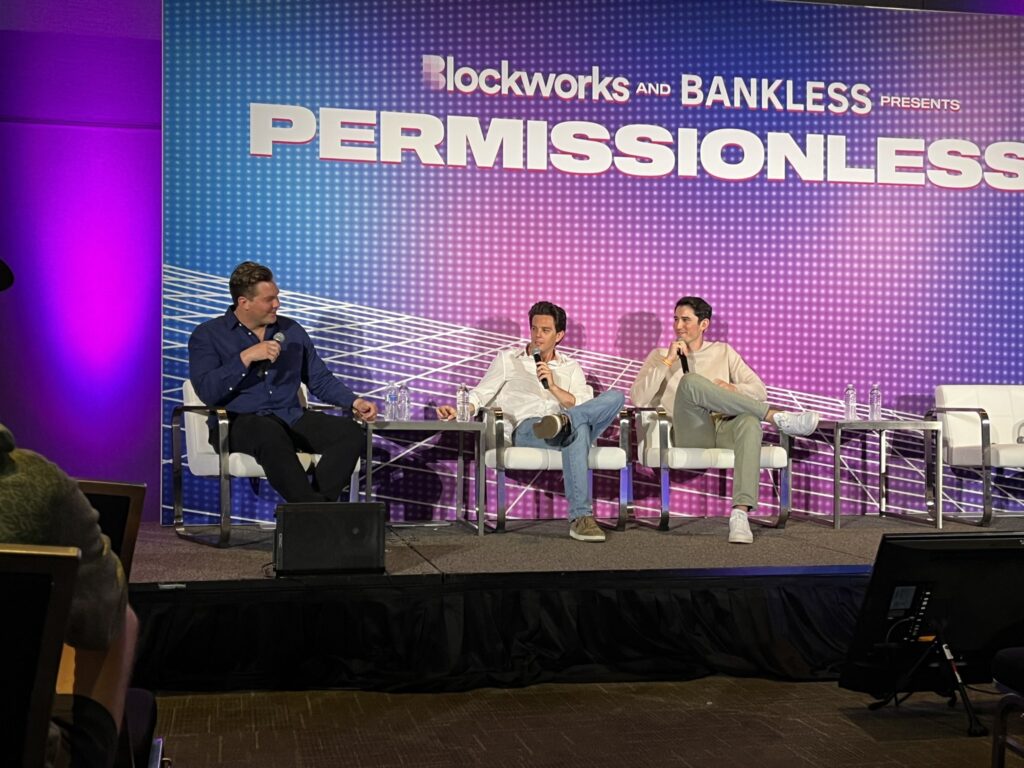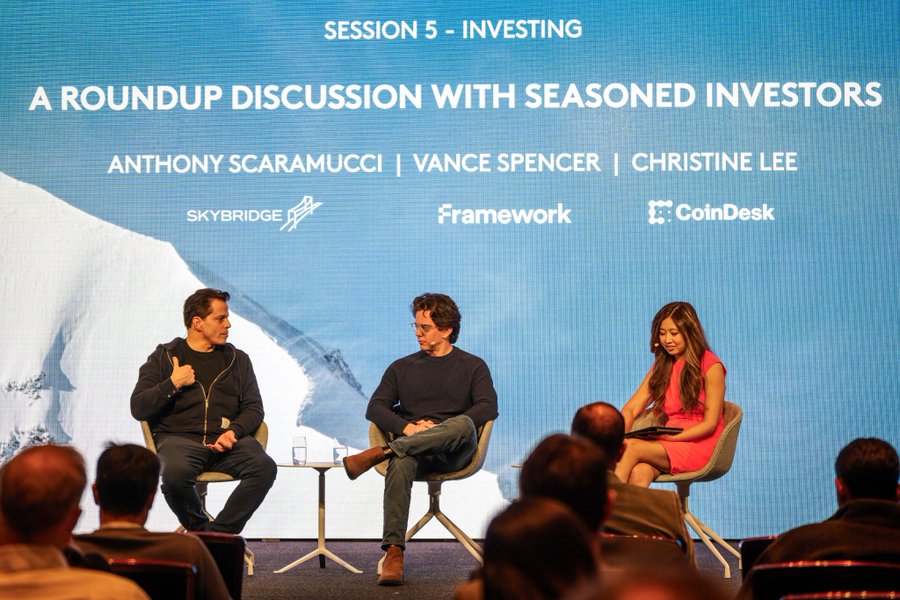Framework Ventures co-founder Vance Spencer recalls the fateful day in 2019 when he and his housemate Michael Anderson went “all in” on their first fund.
Having been into crypto since 2013, the pair were early ETH adopters and scooped up as much as they could afford from $2 while Spencer worked at Netflix and Anderson was at Snapchat and Dropbox.
That nest egg “was certainly a big part” of scraping the money together for the fund, which had just one outside limited partner and also swallowed up the money they’d made from selling their Hashletes digital collectibles business.
“We were all in,” Spencer tells Magazine.
“I remember the day we sold our 401(k)s. I remember the day we sold all our stock in Netflix and Snapchat. And there was basically no Plan B. It was: ‘This was going to work, or it’s gonna be negative net worth.’”
From the beginning, with wildly successful early investments in Chainlink and Synthetix, the firm’s modus operandi was to buy up around 5% of a project’s token supply, roll up their sleeves and stake coins, provide liquidity, trade and try to improve governance.
Spencer says the strategy was born of, “honestly, just desperation. Like we needed shit to work, and we needed it to work in our first fund.”
“Nobody asked us to do it. And frankly, we didn’t know what we were doing half the time, but we learned,” he says.
“The team was two people for the first two years. It was Michael and I [spending] nights at the kitchen table. We didn’t have an office. We didn’t take any management fees from our fund. We just said, ‘Pay us on performance.’”
But with a knack for seeing where things were heading before the rest of the space caught on — too early, in some cases— Framework expanded in 2020 with an $8 million raise that saw the kitchen table work farmed out to Framework Labs, which also ran nodes on Chainlink and The Graph.
$400 million fund for Framework Ventures
When Magazine caught up with Anderson in 2021, the pair had raised $115 million across two funds and invested in Aave, The Graph, Tokemak, Zapper, Uniswap, Compound and more. In April 2022, they raised $400 million for a third fund, by which time Framework had amassed $1.4 billion in assets.
Their success is a big “fuck you” to the Silicon Valley VC community who’d looked down on them when they were first pitching the fund.

“They were like, ‘This isn’t the right model’ — like, ‘Fuck you, you’re not doing it right.’ And I think we still have that. Everyone just perennially disrespects crypto. They think it’s a scam, they think it’s a joke,” he says.
“But I just think it’s the most incredible industry. And we’re here to make Framework work. But we’re also here to make the industry work. There’s not a lot of main characters, good characters, side characters that are still here, and that are still pushing crypto in a positive direction — and we want to be those people.”
Avoiding “dogshit” SBF projects
While some crypto VCs buy in cheap, talk up the project until their tokens are unlocked, and then dump on retail, Frameworks has avoided the easy money so far.
“We had opportunities to invest in SBF’s projects when he was kind of courting us. We had opportunities to invest in clear dogshit,” he says. “And I’m just not, and Michael’s not, willing to do that ever,” he says, noting that their investments all had long time horizons.
“We can hold things in our fund for up to 10 years. And that’s what we intend to do for a lot of these projects,” he says.
Around $200 million of the most recent fund was earmarked for their conviction bet on blockchain gaming, with investments in Illuvium and AI Arena, among others.
Illuvium founder Kieran Warwick recalls they’d spent weeks in grueling meetings with firms and had finally closed the project’s seed funding round when his brother, Synthetix founder Kain Warwick, realized he’d forgotten to introduce them to Framework.
A few minutes into Kieran’s pitch, Spencer requested a brief pause, had a quick chat with Anderson, and then offered to fund the entire round.
“I couldn’t contain my laughter, recalling our exhaustive month of negotiating with over 50 firms. Here we were, moments into a meeting, and they were ready to commit to our entire round. Vance and Michael also thought it was hilarious and blamed Kain for the oversight.”
Kieran says “Vance’s insights and strategies” were crucial to helping the project make it through the bear market.

Ethereum and blind roommate dates
Born in Toronto, the son of a bank manager, Spencer had a “pretty normal middle-class life” — at least until he moved to the U.S. for high school and started experimenting with identities and ideas.
“I was in the communist club in high school. I was really trying to experiment with different philosophies,” he says. “I was the kid who wanted to skateboard and do philosophy but also had really good standardized test metrics. And that’s kind of what got me to college.”
He studied philosophy for a semester in 2009 at the University of Southern California before realizing he “couldn’t possibly get a job” and switched to economics. Upon graduation, he got a job with Monitor Deloitte for a couple of years.
In 2015, a couple of life-changing events happened: First, he read the Ethereum white paper. “Instantly, it was just like a light bulb went off in my head,” he says. “A lot of the things I felt about myself were manifest in this technology. It was tech-forward, but it was fringe.” And Spencer and the Ethereum project both wanted to change the world for the better.
Second, he got a job at a mail-order DVD company called Netflix. “It was not a cool company to join,” he says of his three years at the firm, which saw him move to Tokyo. “But I saw the whole arc of them launching streaming, them launching originals, them launching internationally. It was a blast.”
He says the streaming service was struggling in Japan when he joined, but Japan ended up one of its largest markets in Asia. “And as soon as that happened, I was like, ‘Alright, I want to go do something else.’ And I moved back to the States and started on the real crypto journey with Michael.”
Vance Spencer meets Michael Anderson
Spencer met his long-term business partner, Anderson, on a “blind roommate date” in 2015. Anderson was a Yale graduate who’d been shaken by the financial system meltdown in 2008. The pair bonded immediately and lived together for years, first in Venice, California, and later in San Francisco.
“First dinner, we talked about ETH, and it was on. ETH was like, I think, $2 at that point, and we both just started buying as much ETH as possible. And that was the genesis of our competitive friendship of wanting to scheme on business ideas and do things in crypto,” Spencer recalls.
“I lived in an apartment with him together, and we had no money, and we put everything into the fund. I lived in his mom’s basement for like six months. So yeah, I mean, we’ve been through basically everything together.”
He describes Anderson as “the warm center of the universe. The reasonable one. I’m probably the more hard-charging, you know, on-the-margins frontier [guy].”
“But we‘ve been working together for basically eight years at this point, and we’ve literally never had an argument. It’s rare.”
Framework Venture founders invented Top Shot early
Not everything they touched turned to gold, however. Inspired by CryptoKitties, they foresaw enormous potential in combining sports fandom with NFT collectibles and created Hashletes, an NFL-licensed collectibles game in 2018.
“We created Top Shot before Top Shot existed,” he says of the later, vastly more successful NBA collectibles platform. “I think, ultimately, we were just like a year, or a year and a half, too early.”
“We were the first crypto deal that was negotiated with a major sports league. We were the first real crypto app that was on the iOS App Store,” he says. But the rights cost $6 million a year, meaning that even Hashlete’s 50,000 users weren’t enough to keep it afloat, and they sold it after 18 months.
They took the money from that and their crypto investments and “basically put it all in that first fund. And yeah, I mean, that first one was just like what really put us on the map.”
Investing in Chainlink
Although they’d made angel investments in about 20 projects, it was their 2017 decision to pump between a third and half of their funds into Chainlink’s initial coin offering and LINK tokens at around the $0.15–$0.17 mark that solidified their reputation.
“For us personally, it was everything. On the fund, it was probably that range [of 33% to 50%].”
They’d gotten interested in the project after reading a Cornell University paper called “Town Crier” by Ari Juels (who went on to co-author the Chainlink white paper) that described an authenticated data feed for smart contracts.
At the time, getting reliable data on real-world prices and events into smart contracts was extremely difficult, and problems with this data could cause massive losses — as it did when an errant oracle caused a $1 billion loss in an hour to Synthetix in 2019.
“Blockchains don’t have an internet connection. They can’t go and search Google,” he explains, “Even from the earliest days, even when you didn’t know what the use cases were going to be, you knew that that was gonna be a problem for any of them.”
They were also impressed by Chainlink founder Sergey Nazarov, who’d been in crypto since 2012 when he’d nabbed the smartcontract.com domain. “Back then, there weren’t many good entrepreneurs to invest in,” Spencer says.
You can read their December 2017 Chainlink thesis online. Suffice it to say that LINK blew past their $1 base case and $20 bull case, hitting nearly $50 by 2021. Today’s price of around $20 represents a nearly 12,000% return on the ICO investment.
With Chainlink oracles powering much of DeFi, the investment also opened doors to investments in Aave, dHEDGE Synthetix, Yearn.finance, Dodo, Edgeware, Fractal, Futureswap, Kava, Pods, Primitive, Teller, The Graph and Zapper.

Big bet on Synthetix pays off
The other major early success was buying up “5% or 7%” of the SNX supply at under $0.30 back in 2019. They’d met Synthetix founder Kain at a Polkadot conference and got excited about his plan to pivot the old Havven stablecoin project into a weird new derivatives protocol.
“And we knew derivatives were a big market in crypto, and they were really the first project that was taking aim at that,” he says. “We just knew the community was super strong, we knew Kain was a good leader, and we knew that they were going to do something. We just didn’t anticipate it just absolutely popping off when it did.”
Synthetix built up a head of steam during “DeFi Summer” in 2020, and SNX topped $28 in early 2021. While Spencer won’t go into when or how the fund took profits during the bull market, he says, “A large portion of our portfolio was derisked, you know, at a really good time.”
This is a lesson that anyone who’s seen more than one cycle will tell you: If you never take profits, you never make any money before the cycle ends.
“My first Coinbase account was opened in 2012, 2013. So, I’ve seen this happen, I think, four times at this point,” he says.
Vance Spencer’s predictions about crypto in 2024
While their Synthetix investment has paid off in spades, the thesis that it would grab a decent slice of the derivatives market hasn’t really played out yet— its annual volume is still less than Binance’s daily derivatives volume.
Crypto gaming hasn’t yet come to fruition, either. Around $200 million of the 2022 fund was earmarked for the sector.
“It took longer than I thought to ship these games. They’re not DeFi protocols. You can’t ship it with two dudes and some Red Bull,” he says. So, he thinks it just needs a little more time on the stove.
“Let time pass, and let teams build… I just think it’s been one that hasn’t played out yet.”

But Spencer’s successful predictions vastly outweigh those yet to come to pass. During a Bankless interview in 2019, he predicted that “DeFi TVL would go from $5 billion to $100 billion. And it did, you know, and I invested in all the right protocols to ride that wave. And we did well on that.”
So, how does he see the space evolving today? If you’ve heard him interviewed on Bankless, you’ll be familiar with the SMELL portfolio, which is essentially a core group of protocols that are similar in importance to DeFi as the FAANG stocks are to traditional markets: Synthetix, Maker, Ethereum, Lido and LINK (Chainlink).
“Look at what happened the past 10 to 15 years with tech companies, the ones that were winning, the ones that had distribution, branding, scale — they just kept compounding. And that’s exactly what’s gonna happen here.”
Spencer argues that Maker and Lido, in particular, “both have a path to $500 million to a billion dollars in earnings in the next couple of years.”
“I think in the next year, you’re probably gonna see $10 billion of real-world assets on-chain, and that’ll scale to probably $100 billion to a trillion in the next three or four years after that,” he says, arguing Wall Street will be attracted by lower costs, faster settlement and wider distribution from being on-chain.
That chain will be Ethereum, of course, as big money isn’t going to risk very valuable assets on a blockchain that isn’t bomb-proof: “For now, that market lives on Ethereum.”
Crypto predictions further ahead
He also believes that artificial intelligence will eventually govern decentralized autonomous organizations: “There’s just no reason to have humans in meatspace in the middle. It’s just not a good solution.”
“And I think, you know, if you look back at the previous cycle, the games were some of the biggest outcomes,” he says. “I don’t think you should be surprised if you see one or two or three games just to really grow far faster than people expect.”
Looking further ahead, he says:
“Crypto is inevitable to some extent. And really, all the ideas that have been thrown out there are going to work at some point. So, I think I’m just kind of a steward of it to some extent, and it’s just going to take some time to play out. But I’ve been here for 10 years already. I’m good to do another 20 or 30!”
week.

The post ‘Crypto is inevitable’ so we went ‘all in’: Meet Vance Spencer, permabull appeared first on Cointelegraph Magazine.

